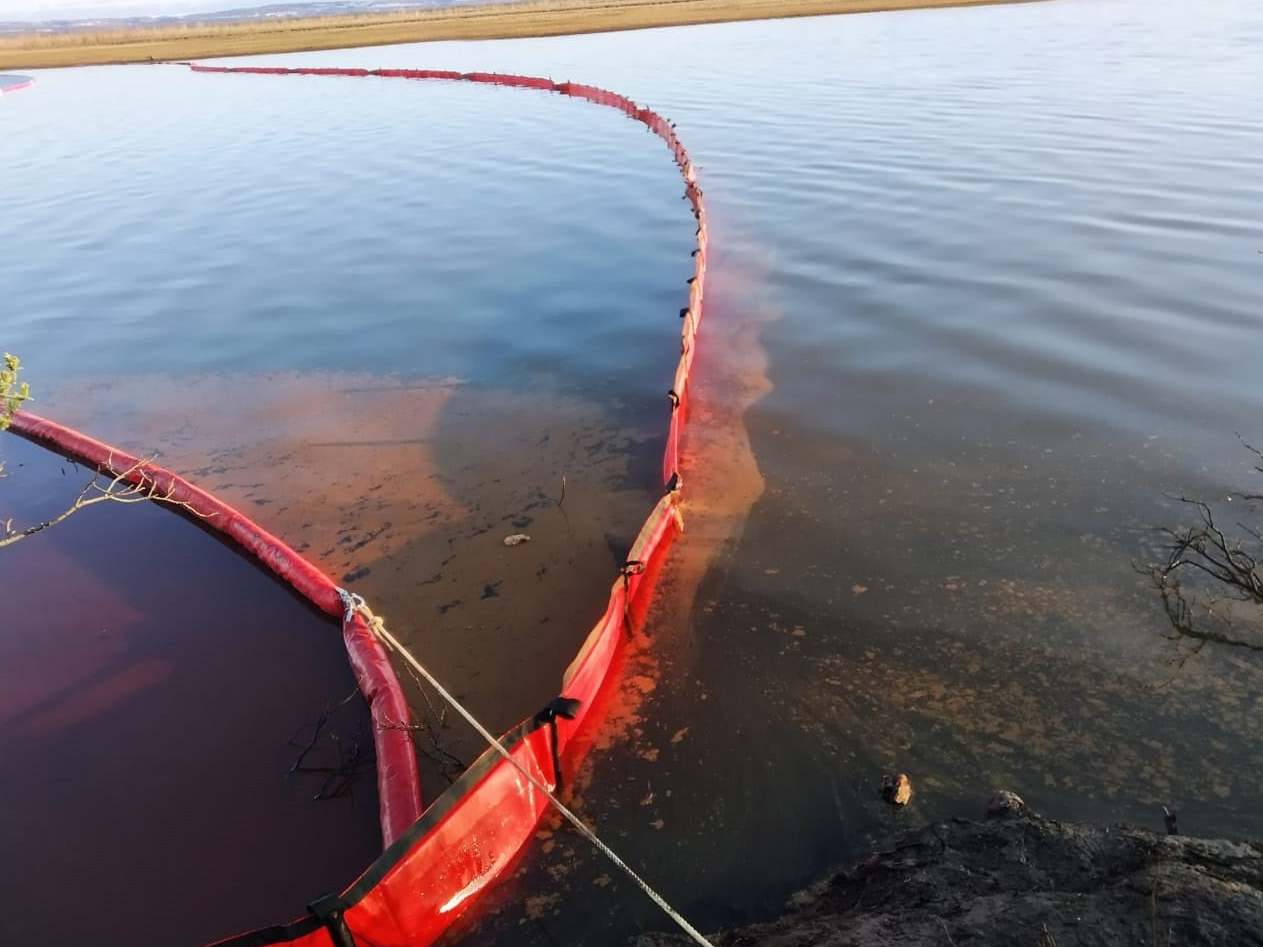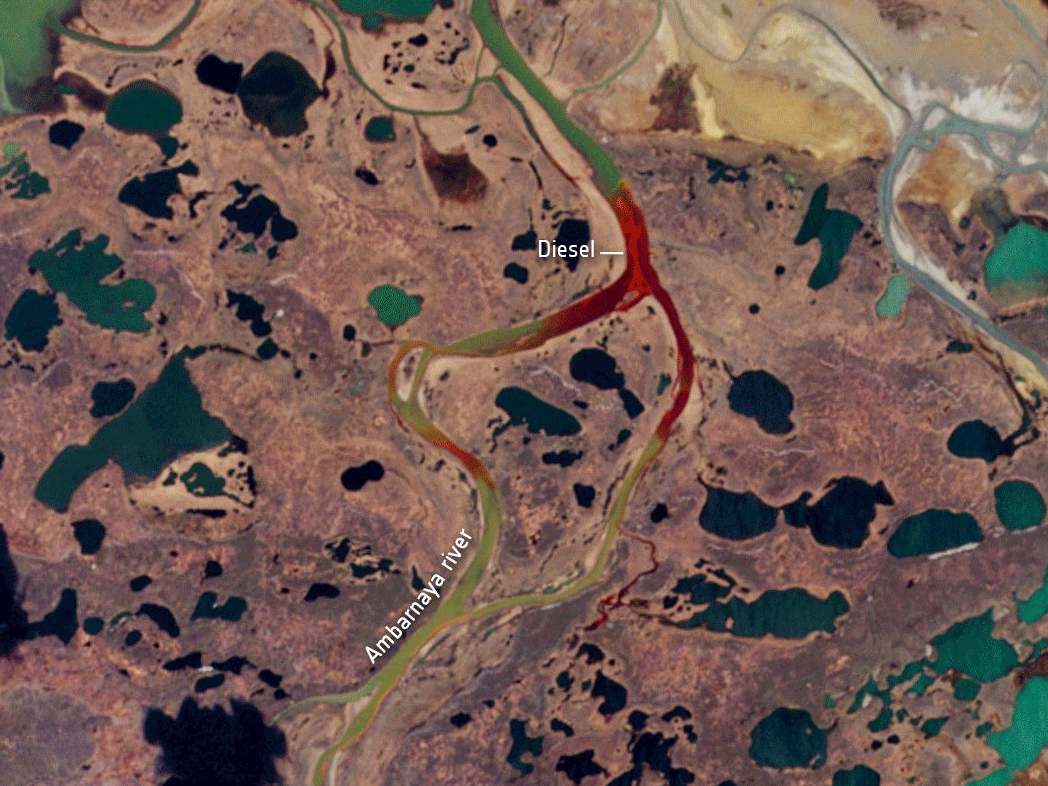What happened in Norilsk stays in Norilsk: Russia battles to contain fallout from the Arctic’s worst environmental disaster
As Putin takes hands-on control of disaster response in Norilsk, a close ally tells the west to keep its distance, Oliver Carroll reports


Two weeks ago, a diesel reservoir failed at a power plant outside Norilsk, Russia’s northernmost city, causing 21,000 tonnes of fuel to outflow into two rivers. It was the Arctic’s worst-ever environmental catastrophe.
Muddled initial reports suggested a car had crashed into the side of the container tower. Witnesses and common sense – the road is dozens of metres away – suggested otherwise.
The not-so-immediate response of authorities added to a sense of confusion. Emergency services were filmed at the scene from the first hours on 29 May, and they sent reports to the regional bosses – who then claimed not to have received them. An official from the local environmental inspectorate arrived later the same evening; his shocking photos from the scene were widely shared across social media by the next morning.
It was only two days after the spill that Alexander Uss, the regional governor, issued the first orders to contain the leak. By the point Vladimir Putin declared a federal emergency on 3 June, the damage was already visible from space.
Since then, hundreds of rescue workers have led a heroic rescue response that seems to have averted the worst consequences of the disaster, namely fuel entering the local lake Pyasino in a substantial way, and moving further north to the ocean.
But it is far from the only massive containment operation at play. Across several levels – corporate management, local, and national government – officials seem just as committed to controlling the political fallout.
Norilsk Nickel, the metal producer that owns the power plant and essentially runs the city, has put the blame exclusively on climate change. The pillars supporting the fuel reservoir sank into what had previously been permafrost, Vladimir Potanin, the company’s billionaire president, said this week. It was impossible to “predict and prepare” for such a “climate-induced” disaster.
“Our provisional assessment is that the pillars suddenly gave way because of changes to the permafrost,” he told Redaktsiya, a local internet TV channel. “There is no emergency manual ... The constructions were not built to withstand a sudden leak of 20,000 tonnes”
Norilsk is a harsh city that is quite literally built on the pillars of slave labour. All across town, its buildings sit on stilts, a unique construction system first invented by engineer Mikhail Kim, who was a resident of the gulag Stalin founded to build the city. Before Kim’s intervention, construction work on the marshy top layers of the permafrost was considered impossible. His solution addressed the problem. What it naturally didn’t do was allow for the climate change emergency that arose decades later.

Environmentalists dispute Norilsk Nickel’s assertion that climate alone was at fault. Some have drawn attention to the fact that the pillars of the ruptured tank were built into rock, not permafrost. Others have speculated that the age of the reservoir, at least 30 years old, and documented evidence of defects and metal fatigue, played at least as important a role. It would also appear that regulations that fuel reservoirs be surrounded by a containment wall were not followed.
Alexei Knizhnikov, Arctic lead for the Russian division of the World Wide Fund for Nature, said it was wrong for Mr Potanin to describe climate change as an “unpredictable” risk.
“Corporate responsibility does not end where the environment begins,” Knizhnikov told The Independent. “Norilsk Nickel’s own company reports accept this. Even if the event is down to climatic factors – and that is an ‘if’ – we are still looking at corporate failure.”
Sergei Shamatov, head of the environmentalist group “Russian Greens”, spent several days at the scene in the week following the spill. Drawing on conversations with local activists, rescue workers and employees of the plant, he argued several issues had likely combined to catastrophic effect.
“The climate factor is very clear, with temperatures in the Arctic growing three times faster than the world average,” he said. “But there are also serious questions to be asked in the field of technical and human error.”
The arrests of three of Norilsk Nickel’s local managers would suggest investigative authorities share that view.
Vladimir Putin’s response to the disaster has been quick and sharp – in contrast to his dithering behaviour over Covid-19. That in itself would indicate a desire to assert and, no less importantly, project control over the situation. For that reason, top managers and local bureaucrats may also have reason to worry.
For the time being, however, the Kremlin seems more focused on containing spillage into international politics.
In a series of public statements this week, Moscow warned its Arctic adversaries – read the United States – not to use the disaster to dent Russian ambitions.
Russia’s Security Council head Nikolai Patrushev, a close ally of the president, admitted the fuel spill was the result of “inadequate risk management,” including climate change. But the major danger for Russia, he said, was that the disaster would “play into the hands of those who seek to discredit Russia’s policy in the Arctic”.
The stakes are certainly high for Russia. Its Arctic interests are not only limited to oil and gas; or projecting military power; or the Soviet-era infrastructure that now desperately needs renewing. They are about new projects like the Northern Sea Route, a short cut between European and Asian markets made navigable by global warming.
The last thing Russia needs is not knowing where the next pipe will burst. Or, Patrushev seemed to be suggesting, for western powers to piggy-back on outrage from the international environmental lobby.
Mathieu Boulegue, a research fellow at Chatham House, said such concerns were not entirely misplaced.
“Norilsk is only the beginning of Russia’s ecological problems in the Arctic,” he told The Independent. “The last decade has seen an increasing number of climate-related incidents, from methane explosions to the reappearance of anthrax, to huge fuel spills, and all seemingly connected to changes in the permafrost. It isn’t surprising that the message is to keep what happened in Norilsk in Norilsk.”
On their part, environmentalists insist ecology is not inherently incompatible with Russian national interests. Some point to Moscow’s history of working with international organisations like the Arctic Council to establish common environmental protections across the region.
“The Arctic is interlinked, a common child,” Sergei Shamatov of Russian Greens said.
“It’s like the International Space Station. We all need to take care of it.”
Join our commenting forum
Join thought-provoking conversations, follow other Independent readers and see their replies
Comments